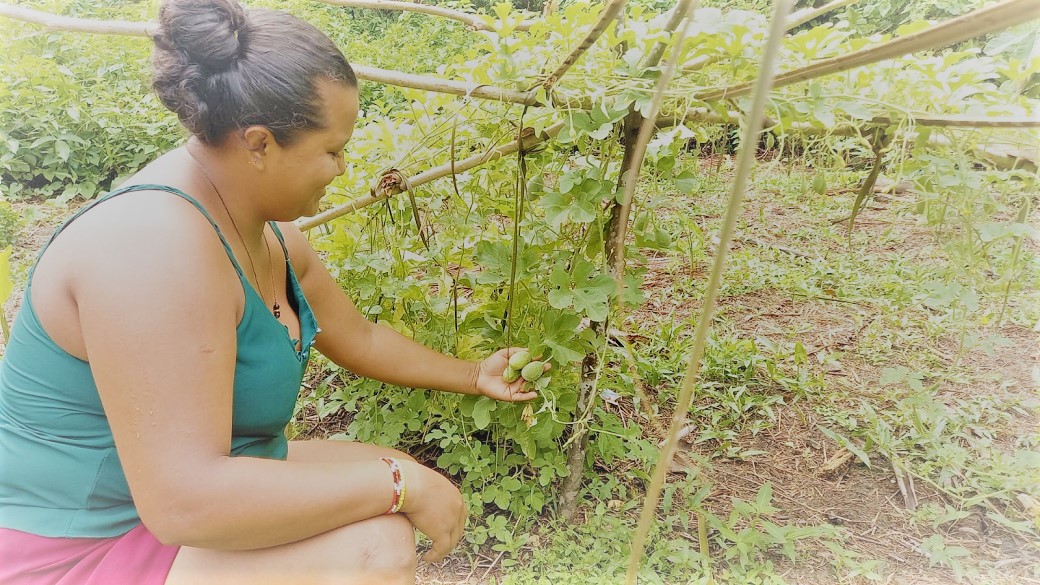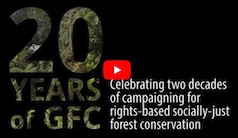Forest Cover 50 – The SDGs and forests: threat, or opportunity of a lifetime?
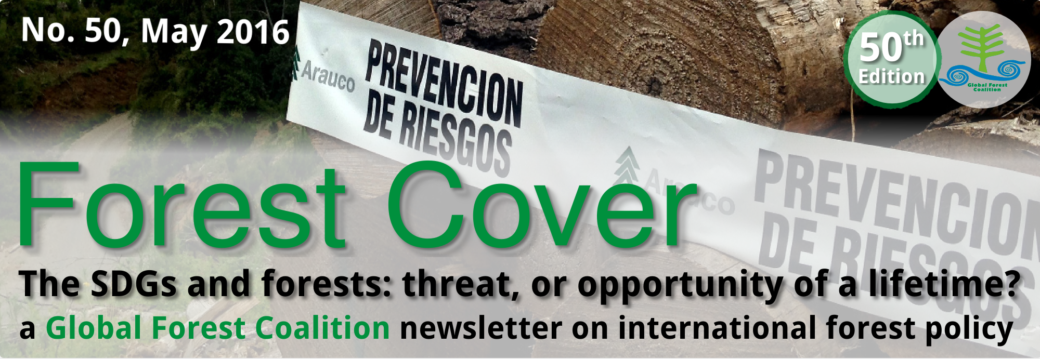
Welcome to Forest Cover No. 50, the Global Forest Coalition newsletter that provides a space for Southern and Northern environmental justice activists to present their views on international forest-related policies.
In this 50th edition of Forest Cover we review the ongoing tension between industrial-scale monoculture plantations and community forest management, considering the impacts of the former on communities in India and Chile, and on women in general, and the biodiversity that they all rely upon.
We look at the way in which these tensions are preventing the implementation of existing legislation relating to community forest management in India, and a successful example of community restoration of ancient oak woodland in Ireland.
Finally we consider the urgent need for the forthcoming UN Environment Assembly 2 to promote policy coherence on environmental matters, in light of the recent business-driven inter-forum fight over the date by which deforestation needs to be halted.
You can download the print version or read the articles individually below. To subscribe to the newsletter, please write to gfc@globalforestcoalition.org
Download the print version (web quality) or (low resolution PDF)
Contents
Preface: About forests, destructive trees and policy coherence
Feature: Forest plantations in Chile, a model to avoid!
Feature: Community ecosystem restoration and the impacts of tree plantations in Africa
Feature: The Great Forest of Aughty
Feature: Gender aspects of biodiversity conservation and the threat of monoculture plantations
– – – – – – – – – – –
About forests, destructive trees and policy coherence
By Simone Lovera, Executive Director, Global Forest Coalition
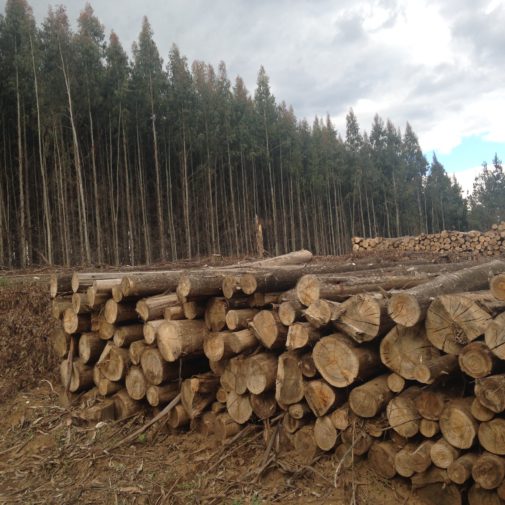
Tree plantations in Chile have caused serious conflicts with local communities. Simone Lovera
Let us start this 50th edition of Forest Cover in a festive mood—sometimes incredible things do happen. For example, five years ago if anyone had told me that in 2015 Heads of State would commit to halting all deforestation by 2020, I would have reacted sceptically, if not cynically.
At the time there were lively ‘zero deforestation’ campaigns by GFC members and other groups, including in large forest countries like Indonesia and Brazil. Yet given the fact that governments had started to emphasise reducing rather than halting deforestation, many of us thought that a global ‘zero deforestation’ target was desirable strategically, but unlikely to be achieved politically. The only international commitment that came close to zero deforestation was Target 5 of the so-called Aichi Targets in the Convention on Biodiversity’s 2010 Strategic Plan, which states, “By 2020, the rate of loss of all natural habitats, including forests, is at least halved and where feasible brought close to zero.”
The way that this rather ambiguous target was translated into the UN’s more robust Agenda 2030 for Sustainable Development Goal (SDG) 15.2 is long and too complicated to explain in a short article. But one point definitely worth noting is that the engagement of business was anything but helpful. In particular, the UN working group on the SDGs had already agreed, in July 2014, on the following target :
However, in September 2014, large businesses—including Asia Pulp and Paper, Cargill, Sime Darby, Unilever and Wilmar International—tried to thrust the process into reverse by signing the ‘New York Declaration on Forests’, along with a number of governments and other organisations. In this they also committed to halting deforestation, but only by 2030. As a result of this declaration, some governments tried to crawl back from the ambitious 2020 UN target over the course of the following 12 months. It was only after a fierce battle that the 2020 target was retained in the final SDGs, which were adopted in September 2015.
However, this did not mean the SDG targets were immediately accepted. For example, Brazil, one of the world’s largest forest countries, published an ‘Intended Nationally Determined Contribution’ (INDC) prior to the Paris Agreement on Climate Change that included a much weaker target, focusing on halting illegal deforestation only, and that only by 2030. The date of Brazil’s submission was 28 September 2015, just three days after the SDGs were adopted by UN members, including Brazil.
Other countries that published INDCs after September 2015, like Bolivia, also ignored the target of halting all deforestation by 2020.
Yet halting deforestation remains critical in terms of dealing with climate change and stemming the loss of biodiversity. Donors and UN institutions should be insisting that countries fully comply with all SDGs, including SDG 15.2, in all fora and including in their climate change commitments.
In addition it is critical that it is the loss of genuine natural forest that is targeted. Plantations of monoculture tree species are no substitute and should not be counted: in biodiversity terms they are a threat rather than a contribution to biodiversity, and they are also poor carbon stores. The fact that the Food and Agriculture Organization (FAO) continues to confuse the two is obscuring what is actually happening—or not happening—with respect to deforestation.
The real and present danger currently facing the world’s forests is the replacement of real, natural forests with these monoculture tree plantations and other severely degraded tree-dominated landscapes. Thus FAO’s September 2015 announcement that the rate of net global deforestation has slowed by more than 50% over the last 25 years is rather less rosy than it sounds. FAO’s figures still include plantations, which it says account for 7% of “the world’s overall forest area” and have increased by over 110 million hectares since 1990.
As long as the UN systems persist in the use of a forest definition that includes basically any kind of collection of trees, including monoculture tree plantations of sometimes invasive alien species like Eucalypt and pine, the second part of SDG target 15.2—to substantially increase reforestation and afforestation—forms a significant direct threat to the other parts of the same SDG target, which call for the conservation of terrestrial ecosystems.
The different articles in this 50th edition of Forest Cover highlight the devastating impacts these tree plantations have, not only on forests and other ecosystems, but on indigenous peoples, local communities and women, who are losing their lands and livelihoods due to the continuous expansion of lifeless tree monocultures in the name of ‘reforestation’ and ‘afforestation’. The first round of 33 participatory assessments of the Community Conservaton Resilience Initiative certainly found that monoculture tree plantations are a significant threat to community conservation initiatives.
This is hugely problematic when it comes to combating climate change. The suggestion in the Paris Climate Agreement (in itself one of the most meaningless agreements ever produced since it lacks binding obligations), is that countries are able to compensate their greenhouse gas emissions by tree planting and other carbon sequestration projects. But this will clearly add insult to injury. More plantations will bring more environmental and social problems, and will undermine the already weak climate regime, especially since trees are such unreliable carbon stores.
Happily, there is good news as well though. The recently concluded meetings of the Subsidiary Bodies on Scientific, Technical and Technological Advice and Implementation of the Convention on Biodiversity in Montreal, in April and May, produced clear recommendations (directed at, for example, the Intergovernmental Panel on Climate Change and the Parties to the Climate Change Convention) to take biodiversity into account in climate change policies and policy options. They also produced an action plan with guidelines on the ecologically responsible restoration of forests and other ecosystems. They even recognised the importance of engaging indigneous peoples and local communities in all stages of the restoration process and recognising their rights, and they acknowledged the fact that women are “powerful agents of change” and that “their leadership is critical in community revitalisation and renewable natural resource management”.[1]
The challenge is to ensure that these worthwhile recommendations, which will hopefully be adopted at the 12th Conference of the Parties to the Biodiversity Convention in December 2016, will subsequently be taken seriously by those same Parties when they participate in climate change negotiations and implement restoration efforts on the ground.
Sadly, however, such policy coherence at the international level remains minimal, as we saw above with respect to the SDGs. Too often, negotiators in one international environmental regime bluntly ignore the outcomes of other international regimes. This is despite the fact that the UN Environment Programme (UNEP) has taken numerous institutional initiatives to enhance coherence in international environmental law.
Now that the UNEP Governing Council has been transformed into a more powerful United Nations Environment Assembly, which will meet for the second time from 23 to 27 May in Nairobi, we can only hope that the Ministers of Environment that come together will start a serious discussion on how they can make sure their very own negotiators do not say “A” in one forum, and “B” in another. The world’s forests and the millions of indigenous peoples, local communities and women that depend on these forests will benefit from improved policy coherence.
Notes:
[1] Last downloaded 7 May 2016. The final report of the SBSTTA meeting will be online in the coming weeks at www.cbd.int
– – – – – – – – – – –
Green India Mission: Undermining community governance and practices in the name of climate change
By Souparna Lahiri, All India Forum of Forest Movements, India

The livelihoods of small-scale farming communities, such as this farmer in Bihar, India, are at risk from the expansion of tree plantations. International Maize and Wheat Improvement Center/Flickr
The National Mission for a Green India (GIM) is one of eight Missions identified under India’s National Action Plan on Climate Change (NAPCC 2008)[1]. An Indian avatar of the payment for ecosystem services approach, the GIM—as forest groups and activists have argued—will lead to increased land grabbing, violation of people’s rights, environmental destruction, and the loss of common lands and livelihoods—without addressing the genuine problem of climate change. GIM’s main green activity is intended to be the expansion of tree plantations, which will destroy biodiversity-rich natural forests and grasslands, and reduce people’s access to forest produce and animal fodder. In particular, the target areas of the Mission include shifting cultivation areas—the areas conserved, used and developed by the indigenous, tribal and forest communities.
The timeline of the Mission was set at ten years with a proposed budget of Rs.46,000 crore (US$6.8 billion). Ostensibly GIM aims to enhance carbon sinks in sustainably managed forests and other ecosystems, while maintaining the resilience and ability of vulnerable species/ecosystems to adapt to a changing climate, and enabling adaptation by forest dependent local communities in the face of climatic variability. GIM’s intended outputs includes a doubling of the area for afforestation/eco-restoration in India over ten years, supposedly ensuring that India’s forests make an increasing contribution to India’s greenhouse gas (GHG) removals.
At the organisational level, the Mission document commits to the Gram Sabha[2] set up under the Forest Rights Act or the Extension of the Panchayat Raj[3] Act in Scheduled Areas, and various committees set up by it are supposed to be the key institutions for planning and implementation at the village level. The Mission also committed to ensuring that areas where GIM is implemented will first have to comply with the provisions of the Forest Rights Act 2006. However the Mission also allowed the backdoor entry of revamped Joint Forest Management Committees (JFMCs) under the Gram Sabhas to protect, regenerate and sustainably manage forests. The governance pattern also includes the revamped Forest Development Agencies (FDAs) as supposedly democratic and inclusive institutions contributing to decentralised forest governance. Forest peoples’ movements have consistently opposed JFM, insisting that JFMCs be scrapped, with this being a key demand during the struggle for enactment of Forest Rights Act, which was at its peak during 2005-06.
The draft of the Mission was circulated for comment and limited consultation in June 2010.[4] The Government of India adopted GIM as one of its REDD+ instruments, and the Cabinet Committee on Economic Affairs approved GIM as a Centrally Sponsored Scheme in February 2014. According to the Ministry of Environment, Forest and Climate Change, the guidelines for GIM were eventually finalised in 2015, but there is still no updated activity reported by the Ministry. However, it is clear that the government has not been able to mobilise much funding for GIM and it seems that the Ministry has therefore decided to dovetail GIM with other programmes and schemes, one of them being CAMPA (Compensatory Afforestation Fund Management and Planning Authority).[5]
This is a critical development. The participation of the forest communities and the Gram Sabha, which is essential to the notion of decentralised governance, is diluted by this convergence, because CAMPA is strongly centralised at both the central and state government levels, and fully controlled by the forest departments. It is essentially a fund based on payments for compensatory afforestation and Net Present Value (calculations arrived at by putting a certain monetary value to the area to be deforested for a project) made by developers whose projects will destroy forestland. By the end of 2015 this fund amounted to Rs.40,000 crore (US $6 billion).
The forest groups have questioned the Mission’s governance system since the beginning, because it gives such a prominent position to the FDAs rather than community governance mechanisms. The GIM’s institutional structure itself exposes and runs contrary to the rhetoric of the overall GIM document, and this situation is exacerbated by the merger with CAMPA. Forest peoples’ movements have responded to the Mission document by emphasising that, “Any such Mission has to begin with a democratic framework that, in particular, disempowers the Forest Department and creates the space for genuine people’s empowerment. This document does the opposite.” [6]
The 2015 guidelines clearly reflect the apprehensions the forest peoples’ movements have about the Gram Sabha being undermined, as they state that the plans will be approved by the respective Gram Sabha, but they qualify this by adding that financial powers may be jointly exercised by the JFMC President and the Member Secretary. In essence, this effectively means that Gram Sabha will be used as an approving authority only, while actual activities will be carried out by the JFMCs—even though these are bodies which have no place or role in the collective and community driven forest governance regime recognised by the Forest Rights Act 2006.
The 2015 guidelines also talk of private sector engagement in developing plantations and agro-forestry practices outside forest areas in line with the enhancement of carbon sinks and sequestering carbon. There is genuine concern that this is another route whereby the Mission will facilitate the expansion of monoculture plantations, as the document has not ruled out such plantations, and the policy will convert people’s homelands and livelihood resources, without even consulting them, into tradable commodities, through the system of carbon trading.
However, the guidelines do seek people’s engagement through Community Conserved Areas (CCAs) and Sacred Groves. They define Community Conserved Areas as “Natural ecosystems (forest/marine/wetlands/grasslands/others), including those under minimum to substantial human influence, containing significant wildlife and biodiversity value, being conserved by communities for culture, religious, livelihood, or political purposes, using customary laws or other effective means”. While this aspect of the GIM seems to promote good practice with respect to engaging with forest communities, it has to be kept in mind that the CCAs and sacred groves have no legislative support in India and cannot be left to the JFMCs. JFMCs are not community collectives capable of protecting CCAs and sacred groves, organisationally or conceptually.
From the architecture of the GIM and the content of the 2015 guidelines, we can conclude that there are clear indications that the role and power of the forest communities and their conservation practices may be about to be sacrificed on the altar of carbon sequestration. But the implementation of GIM is currently slow, making this an opportune time to redouble calls to strengthen the Gram Sabhas and community conservation practices, and outline the details of a more credible community governed forest conservation and protection regime in the near future.
Notes:
[1] For a summary of the Missions see Center for Climate and Energy Solutions, http://www.c2es.org/international/key-country-policies/india/climate-plan-summary, accessed 5 May 2016.
[2] Village council comprising all adult members of the village
[3] Form of self governance at the third tier below the federal state
[4] The draft GIM was released in 2010 and can be accessed at http://www.moef.nic.in/downloads/public-information/green-india-mission.pdf
[5] To find out more about CAMPA the Indian Supreme Court Order establishing CAMPA can be accessed at http://envfor.nic.in/sites/default/files/CAMPA-SC%20order.pdf
[6] SouparnaLahiri, All India Forum of Forest Movements, The Road to REDD+, a presentation made in the Regional Consultation on REDD and GIM, Bangalore, December 2010
– – – – – – – – – – –
Forest plantations in Chile, a model to avoid!
By Carolina Lagos, Colectivo VientoSur, Chile
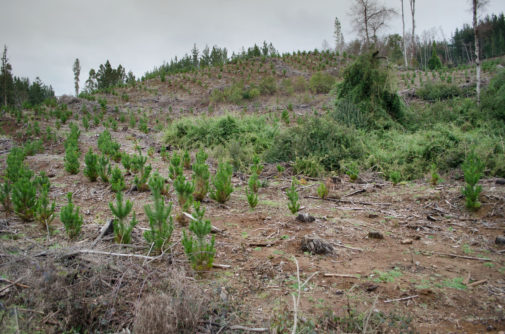
A re-planted pine plantation in an area currently experiencing conflict between communities and plantation owners in Chile. Carolina Lagos/CIC
The forestry development model that has been implemented in Chile over the last 40 years is often depicted as a success because of the economic growth generated. It is currently rated second only to mining in terms of its contribution to the country’s Gross Domestic Product. However, a close analysis of the model shows a high degree of concentration of property in the sector, along with numerous negative environmental and social consequences.
Given the possibility of further expansion of this model at the national level, as well as interest in replicating the model in other countries, it is important to analyse the Chilean experience in more detail. Who are the beneficiaries? And who are affected by the many negative consequences generated by the industry, particularly with regard to our indigenous peoples?
Since the beginning of the last quarter of the twentieth century, forestry in Chile has received strong support from the state and, intended or not, this has contributed to the concentration of economic benefits in just a few hands. Indeed, one of the key factors in the expansion of forestry was the State’s contribution to promoting it through Decree-Law N° 701 on Forest Plantations, an instrument that has subsidised and created tax breaks for plantation establishment since 1974. This policy contributed decisively to both the expansion of pine and eucalyptus monocultures, and the concentration of this activity.
Thus, during the first stage of implementation of this regulation—that is, up until 1997— more than 94% of the plantations being subsidised belonged to large and medium enterprises and only 5.8% to small businesses owners.[1] Subsequent amendments to the decree did attempt to reverse this trend, but looked at in the round over 40 years, it is still clear that 70% of the profits have gone to large and medium enterprises. As a result, just three holdings are now receiving more than 70% of the profits generated by the exports in this sector, and the same groups are owners of more than 67% of the plantations.[2]
Growth in the forest industry and related exports has not been translated into social benefits. One of the arguments used in favour of forestry is employment generation, but the industry has tended towards producing and exporting low added value products, which limits its demand for labour. The overall analysis shows that the sector occupies an area of more than three million hectares of land, which are now covered with pine and eucalyptus plantations, while the jobs generated number fewer than 130,000—just 1.64% of the national total and just one job for every 23 hectares of plantations. In addition, a sustained reduction in the number of jobs per hectare, combined with low salaries and job instability,[3][4] has also been identified.
The main problems associated with forestry expansion are experienced by peasant communities and indigenous peoples in general, and the Mapuche people in particular, who have been displaced and are unable to maintain their traditional economies, ancestral practices and ways of life, due to the various negative impacts of forest plantations and associated industries on ecosystems.
Biodiversity loss
Studies done by research institutions consider the Chilean model of forestry development to be the main factor underlying the loss of native forests in Chile[5] and thus, of biodiversity loss. This is because it is estimated that the growth of plantations has been achieved mainly through the substitution and replacement of native forests. This causes deterioration of the quality of life of rural communities and the Mapuche people, who have traditionally extracted various non-wood products that are part of their diet from the forest, including seeds, fruits, various species of fungi, and plants that are used in their traditional medicine. In addition, a breakdown of ecosystem balance is observed in natural food chains in the forests, and there are reports of more frequent deaths of livestock and poultry because of a rising number of attacks by predators.
It is also important to note that the temperate forests of Chile have been classified as stress points in terms of conservation, both for their high level of biodiversity and their degree of endemism. They are among the most threatened eco-regions in the world.[6]
Pollution, cultural erosion, water shortages
Pesticides used in forest plantations pollute soil and water, preventing subsequent food production using those resources. Communities also report damage with respect to beekeeping. Moreover, pulp mills linked to forestry pollute water, soil and air, causing the death of birds, fish and algae, and crop losses in the territories as a result of acid rain (which is formed by the gases released from processing plants coming in to contact with mist or rain). These conditions directly affect indigenous communities’ agricultural and livestock activities and prevent traditional uses of forest related to their ancestral medicine and religion. They also have direct impacts on people’s health, and various cases of respiratory problems and cancer have been reported. Clear-cut harvests leave the soil exposed to the action of rain, causing soil erosion and increasing the risk of landslides, which has been reported as one of the greatest fears of the communities in the region of Bio-bío.
This activity also creates social problems, as changes in land ownership in favour of forestry companies have generated migration and the relocation of families and even entire communities, who subsequently have little or no adaptation to their new environment. This encourages the migration of young people from the countryside to the city, in search of greater opportunities for personal and economic development, and accentuates the cultural erosion and loss of ancestral knowledge and practices.
Perhaps the most pressing and immediate concern, however, is the high rate of water extraction from aquifers, which is a direct result of the expansion of tree plantations. This has led to a dramatic decline in water resources, a situation that is particularly acute in the summer period, even in regions with annual average rainfall of 1,200 mm. Due to this, regional governments have been forced to supply water to communities by shipping it in in trucks. However, this supply is limited and only meets the needs of human consumption. There are therefore severe impacts on animal breeding, crop production, and the propagation of native species for medicinal use and for forest conservation and restoration. This makes plantation forestry the main threat to cultural and ecosystem conservation from peasant and indigenous communities’ perspective, and problems related to this have been the cause of escalating conflict with the Mapuche people communities in Chile in 2015 and 2016. They continue to demand the return of their land, respect for their dignity and recognition of their rights to self-determination and to maintain their traditional lifestyles.
National and international policies urgently require a change, in light of research showing that tree monocultures are not sustainable, in such a way as to curb replacement and encourage the recovery and restoration of native forests and ensure the conservation of our indigenous peoples’ cultures, which have been intimately linked to the forests throughout history.
Notes:
[1] AGRARIA, 2005. “Informe final Evaluación de Impacto Programa Bonificación Forestal D.L. 701”. Ministerio de Agricultura, Conaf. Santiago, Chile. 226 pp. Available through: Dirección de Presupuesto, Gobierno de Chile on line website.
http://www.dipres.gob.cl/574/articles-141195_informe_final.pdf. Accessed April 23, 2016
[2] Frêne, C., Núñez , A .2010. “Hacia un nuevo modelo forestal en Chile”. Revista Bosque Nativo 47, 25-35. Available through: Revista Bosque Nativo on line website.
http://www.bosquenativo.cl/descargas/Revista_Bosque_Nativo/RBN_47_art_op2web.pdf. Accessed April 23, 2016
[3] Espinoza, M., Riquelme, V., Rojas, I., Yanes, H. 2008. “Precarización del empleo, ¿un mal moderno?” en Temas laborales N°5. Dirección del trabajo, Chile. Available through: Dirección del Trabajo, Gobierno de Chile on line website
[4] OLCA. 2013. “Cultura local y modelo forestal: Una transición forzosa: El Caso Carahue”. Investigación del Observatorio Latinoamericano de Conflictos Ambientales. Septiembre de 2013. 23 pp. Available through: Observatorio Latinoamericano de Conflictos Ambientales on line web site.
http://olca.cl/oca/informes/Cultura-Local-y-Modelo-Forestal.pdf. Accessed April 20, 2016
[5] Aguayo, M.; Pauchard, A.; Azócar, G.; Parra, O., 2009. Revista chilena de historia natural. “Cambio del uso del suelo en el centro sur de Chile a fines del siglo XX. Entendiendo la dinámica espacial y temporal del paisaje”. Available through: Scientific Electronic Library on Line Chile website. http://www.scielo.cl/scielo.php?pid=S0716-078X2009000300004&script=sci_arttext . Accessed July 31, 2015
[6] Echeverría,C., David, C., Salas, J., Rey-Benayas, J.M., Lara, A., Newton, A. 2006. “Rapid deforestation and fragmentation of Chilean Temperate Forests”. Biological Conservation 130: 481-494. Available through: Universidad de Concepción on line web site.
http://www2.udec.cl/~crisecheverria/PUBLICATION_files/Biol_Cons.pdf. Accessed April 20, 2016
– – – – – – – – – – –
Community ecosystem restoration and the impacts of tree plantations in Africa
By Kureeba David, NAPE, Uganda

A transect through Kikandwa communties as part of the Uganda CCRI. NAPE/CIC
In this era of climate change Africa has turned out to be a hot spot with respect to forest-related carbon offsetting and trading projects, including REDD+ projects (Reducing Emissions from Deforestation and forest Degradation), and forest carbon plantation projects. In many countries communities that used to own land are being internally displaced, and their land turned over to companies for these projects. In this way, such projects are actually accelerating climate change vulnerability.
In areas where natural forests existed, companies have replanted with pines and eucalyptus, with total disregard for community land rights. This situation is being exacerbated by the fact that although various African countries have laws that govern environment, forests and natural resources, the effective implementation of these laws also remains a challenge.
Numerous companies that claim to be engaged in environmentally friendly forestry processes, are actually planting exotic pine and eucalyptus species to maximise profits from bioenergy and carbon offset finance, at the expense of environment and community livelihoods. These companies include Bidco Uganda Limited, Global-Woods in Kikonda Forest Reserve, and Green Resources in Uganda, Mozambique and Tanzania.
For example, when one reads Green Resources’ website it portrays itself as a company intent on improving community livelihoods. But in reality it’s the reverse. As it also says on its website:
“Green Resources is Africa’s largest forestation company and a leader in East African wood manufacturing. The company has 45,000 ha of standing forest in Mozambique, Tanzania and Uganda, established through its own planting activities. It operates East Africa’s largest sawmill in Tanzania and electricity pole and charcoal plants in Mozambique, Tanzania and Uganda and is also one of the first companies globally to receive carbon revenue from its plantation forests”.[1]
What do communities benefit from this? Especially given that most of the areas occupied by the plantations were formally community land or government land.
Green Resources is also clearly targeting the additional finance streams available in terms of bioenergy and bio-chemicals made from forest products, and climate finance:
“Green Resources holds land enabling the company to establish close to 200,000 ha of additional plantations with an aim to serve the growing regional and global demand for wood products. Its strategy is based on growing wood for both traditional uses (sawn timber, panel board, packaging, tissue, etc.) and for the growing bio-chemical and energy sectors. It is a leader in carbon finance with four validated reforestation projects.” [2]
There are also human rights violations associated with the establishment of these plantations, For example, Global Woods has been accused of violations in Kikonda[3], including arbitrary arrests, the confiscation of cattle, and widespread corruption amongst forest rangers employed by the company. Affected communities have taken the company to court over land grabbing[4].
In Liberia, in 2009, Malaysian based company Sime Darby, through its division Sime Darby Plantation, signed a 63-year concession agreement with the government for 220,000 hectares of land to be developed into oil palm and rubber plantations. A new company, Sime Darby Plantation (Liberia) (SDPL) was set up to manage the plantations. The concession area is spread across four counties: Grand Cape Mount, Bomi, Bong, and Gbarpolu. Under the concession agreement, SDPL was supposed to work with smallholders to develop an additional 44,000 hectares under an Outgrowers’ Scheme. SDPL and other oil palm companies were required to undertake Social and Environmental Impact Assessments (SEIA) and High Conservation Value (HCV) assessments before any development begins. However, it seems that communities were not adequately consulted. The companies went ahead and did the assessment anyway. In addition to that the recommendations/mitigations of the assessment were not enforced, and ultimately the environment was degraded.
In this era of industrialisation and climate change the only solution to saving community livelihoods and environment is Community Ecosystems Restoration. It is a complex task, and likely to be slow going since governments erroneously regard community approaches as primitive, and because large tracts of land have already been given out to plantation companies. The disgraceful way in which corporations have treated communities as mentioned above has also triggered forest loss and therefore climate change, biodiversity loss, water contamination and food insecurity, all of which need to be recovered.
This approach involves empowering communities in line with the Convention on Biodiversity Convention’s Aichi targets, especially Target 1: “By 2020, at the latest, people are aware of the values of biodiversity and the steps they can take to conserve and use it sustainably.” The aim of the Community Conservation Resilience Initiative (CCRI) is to perform a bottom-up assessment of the resilience of the initiatives and biocultural approaches of Indigenous Peoples and local communities with respect to conserving and restoring biodiversity, and assessing the legal, political, socio-economic, financial, technical, and capacity-building support that could be provided to sustain and strengthen these initiatives and approaches.
CCRI initiatives are being conducted and promoted in Tanzania, Kenya, Uganda, the Democratic Republic of Congo and Ghana. It is important to note that these initiatives are taking place near or in areas that have been degraded by corporations. In Uganda, the communities have demanded the return of their ancestral land and they are currently suing the perpetrators. Back to back with the court process are community dialogues, and tree planting around the community in small pieces of land/plots that have remained, in order to regain energy sovereignty and biodiversity. In Kenya, the Indigenous Information Network (IIN), under the CCRI, is organising a meeting for two communities, the Olorine community and the Kimindet community, who have been struggling to secure resource rights in the same territory. This meeting is considering how to harmonise access rights, ownership and the role of government in managing resources.
Governments especially in Africa should do everything possible to promote community conservation and respect community land tenure rights if Aichi Target 11 and others are to be met. Target 11 reads “By 2020, at least 17 per cent of terrestrial and inland water areas and 10 per cent of coastal and marine areas, especially areas of particular importance for biodiversity and ecosystem services, are conserved through effectively and equitably managed, ecologically representative and well-connected systems of protected areas and other effective area-based conservation measures, and integrated into the wider landscapes and seascapes”. Conservation should be for communities by communities and plantations should not be regarded as forests.
Notes:
[1] http://www.greenresources.no/
[2] http://www.greenresources.no/
[3] http://www.goldstandard.org/sites/default/files/goldstandard_statement_kikondaproject.pdf and http://www.redd-monitor.org/2016/01/08/global-woods-plantations-in-uganda-trees-versus-food/
[4] Read more about the court case: http://www.theguardian.com/global-development/2015/mar/03/ugandan-farmers-take-on-palm-oil-giants-over-land-grab-claims
– – – – – – – – – – –
The Great Forest of Aughty
by Andrew St Ledger, Public Relations Officer, The Woodland League
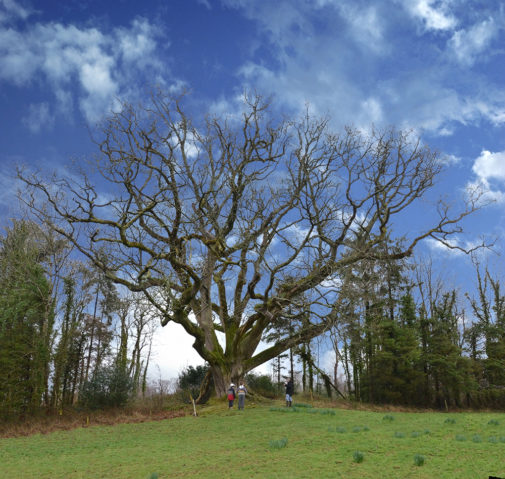
The 1000-year old Brian Boru oak tree in Raheen ancient oak wood. Andrew St Ledger
The Great Forest of Aughty is a Woodland League, active, grass roots-led native woodland restoration project in East Clare and South Galway, in the Republic of Ireland. This project aims to bring farmers, local communities, schools, private landowners, local authorities and public land managers together to restore, conserve, and expand the remaining shreds of ancient Irish woodland within the footprint of what was once a mighty oak forest, covering 100 square miles.
Today less than 0.002% of Ireland’s land area consists of ancient woodland. The Woodland League consider this a crisis, as Ireland’s authentic landscape is western Atlantic Temperate Rain forest, hyper oceanic[1], and rich in epiphytes and bryophytes.
Ireland’s ancient Brehon laws, operative from 500 BC to 1700 AD, used to protect this great resource, which allowed for a golden age in Irish history, when the Island was known as ‘Inis na Bhfeodha’ (Island of the Sacred Trees). This period, between the 2nd century AD and the 12th century AD, produced numerous illuminated manuscripts, such as the Book of Kells, as well as a treasure trove of wonderful nature poetry, metalwork and woodwork (although the latter has not survived as wood is very perishable especially in a very wet climate).
However, Ireland’s calamitous history between the 12th and 20th centuries resulted in tree cover being reduced from approximately 70% primeval forests to less than 1%. This was the result of 800 years of war and asset stripping by the Crown forces of England. Forests were cleared for agriculture and towns, and timber harvested, firstly for the Royal Navy’s ships and then for iron production in the 17th century, which saw the last of Ireland’s forests laid low.
Ireland was the first British colony and the model for future colonisation. This period between the 16th and 17th century saw massive deforestation—no other European country suffered such a loss of native biodiversity in such a short period of time.
At the beginning of the 20th century, the Crown finally decided to restore Ireland’s forests, but they chose the non-native industrial-scientific plantations model, and this is what the Irish State, despite winning a form of Independence in 1922, has continued to work with until the present day. As a result Ireland now has 11% tree cover, but this mostly consists of monocultures of exotic conifers.
This then is the context of our restoration project which we hope will become a model for other regions of Ireland that are similarly bereft of native tree cover.
In 2008 the Woodland League joined forces with a local community, who had been gifted a four acre woodland site, and another environmental NGO called CELT (Centre for Environmental Living and Training), to develop the site as a model for native woodland restoration. It had been clear-felled of conifers almost fifteen years previously and was regenerating with a mixture of native trees and exotics. We developed a management plan to enhance this process and bring the site back to a mature and stable climax oak canopy. We have worked mainly on a voluntary basis and over a number of years. The project has been a great success. For example, in 2014 it won an award in an All Island Pride of Place competition, in the eco-community category. At this stage the Tuamgraney community native woodland had become a much used community asset at many levels including as a model for native woodland restoration.
In 2009 we produced a document called a “Pilot project proposal for integrated forest management in East Clare.” This was after Ireland’s orchestrated and catastrophic financial crash in tandem with the global recession. We proposed to map and restore the pockets of ancient woodland in the area as well as seeking to expand and manage existing farm and private woodlands, which were without management plans. The objective was to train up local teams of unemployed people to carry out this essential work and create meaningful local employment, while also making local communities resilient in the face of economic and climate meltdown. We listed the multiple benefits that could accrue, such as alternative energy resources, climate change mitigation including flood alleviation, biodiversity enhancement, and water source management and filtration.
In the meantime we drafted a wider plan to join the community woodland to the pockets of ancient forest via rivers and streams, to create ecological corridors using the pilot project as a framework. We were offered the digital mapping technology of an award winning Irish company called Treemetrics, which we have not yet fully utilised. Then in 2013 the owner of Raheen estate, who had originally gifted the four acre site to the local community, asked us to help him conserve a further 40 acres of his ancient oak wood, based on what we had achieved with his gift of four acres. We guided him to commission a Sustainable Forest Management (SFM) plan, which he did, and then he surprised us by adding another 200 acres of his estate into the plan. This is now the largest private native oak forest restoration project in Ireland.
There are currently six different oak restoration models ongoing in Raheen estate. These include non-native conifer removal, natural regeneration, some planting and a fifty metre square coppice area which we have used for a training course in sustainable forest management. CELT received funding for the SFM training and we assisted in creating the modules using the pilot project plan. This was a great success with twenty people travelling from all corners of Ireland to complete the twelve workshops combining theory with practical demonstrations. We now plan to bring these workshops to other parts of Ireland and share this know how, to encourage the restoration of the broken relationship between people and their native woodlands, which is the mission of the Woodland League.
In 2015 our Great Forest of Aughty proposal merits were recognised by the internationally renowned body NINA (the Norwegian Institute for Nature Conservation) and they invited us to participate in a pan-European upland native forest restoration project with four other countries, seeking funding under the EU Horizon 2020 research funding programme. Unfortunately the project did not get past the second stage this time but we are confident of obtaining funding in the near future. Either way we are continuing with small amounts of funding and much goodwill, on the understanding that this train is moving forward with one very valuable by-product, Community Restoration!
Notes:
[1] Hyper Oceanic Temperate rainforest is found in areas of extreme oceanic climate, very wet and distinguished by adapted oak woodlands, which can deal with salt in the air and rain, hosting a rich diversity of lichens, mosses and ferns, all which love the damp moist oceanic conditions
– – – – – – – – – – –
Gender aspects of biodiversity conservation and the threat of monoculture plantations
By Isis Alvarez, Gender Adviser and Campaigner, Global Forest Coalition
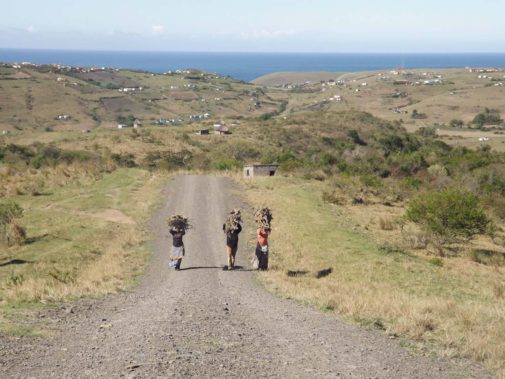
Women in South Africa making the daily journey to collect firewood. Russ Keyte/Flickr
Women’s involvement in the sustainable management and conservation of natural resources is being increasingly recognised in intergovernmental processes. Nowadays, full Gender Action plans can be found in two of the most important environment-related agreements, the Convention on Biological Diversity (CBD) and the UN Framework Convention on Climate Change (UNFCCC). This, many reckon, is an important advance in gender equality and women’s rights. But they do not go far enough.
The recognition of women’s important role in natural resources management comes from a deeper understanding of the differentiated roles of men and women. While women are more dependent on natural resources for their livelihoods and thus spend longer time in direct contact with them, men tend to be more involved in the market value chain of related products (such as wood for timber and charcoal, for example).[1] Increasingly, literature refers to the amount of time women spend collecting non-timber forest products (NTFPs), wood for fuel and electricity, and—more widely studied—water. In fact, a study of time and water poverty in 25 sub-Saharan African countries estimated that women spend at least 16 million hours a day collecting drinking water, compared with men, who spend six million hours, and children, who spend four million hours.[2] Polluted streams mean that women have to walk longer to find a source of drinking water, and loss of forests and biodiversity makes it harder for them to collect firewood, NTFPs, etc. In short the more degraded the environment and/or the scarcer the resource, the bigger the burden for women in terms of so-called ‘drudgery’.
Furthermore, more time spent on these mundane tasks means that there is less time available for education, which also impacts on women’s capacity to participate in decision-making, with respect to land use and forest management for instance. At the same time, having to travel longer distances also increases the risk of physical attacks and sexual violence for women and girls, who may have to travel alone.[3]
In addition, women and girls take care of the young and the ill without any economic compensation, also known as women’s unpaid care work. This is also implicit in their lack of education, again making it difficult to participate in decision-making processes. This situation may be exacerbated by the fact there may be more family members falling ill as a result of water and air pollution.
Women also suffer increased domestic violence as the resources they traditionally depend upon become scarcer and they have to depend economically on their partners. Some societies even deny inheritance rights to women,[4] preventing them from securing land use rights.
Furthermore agreements such as the UNFCCC tend to focus on false solutions that are not only failing to address the problematic of reducing greenhouse gases, but creating increased pressure on and threats to women. For example, by ramping up the focus on markets in forests and now the agricultural sector, the UNFCCC is driving a process that is seeing bigger chunks of land being grabbed in the Global South, in order to establish extended monoculture tree plantations for so-called carbon credits (REDD+), bioenergy, etc. Climate Smart Agriculture is similarly in the spotlight. Both approaches expand the imposition of monocrops, monopolising vast areas of land and constraining women’s use of and access to that land.
Therefore, even though Gender Action Plans and Gender Decisions may strive for better inclusion, the reality is that the overall agreements are, at the same time, advocating for issues that will definitely continue to have strong negative impacts on women’s lives and livelihoods.
For example, issues of concern in a study on Gender and Plantations in Indonesia[5] included:
- Land acquisition by plantations and environmental damage
- Degradation of customary institutions
- Deficiencies in smallholder schemes
- Unemployment
The World Rainforest Movement in its publication ‘Women, Forests and Plantations – the Gender Dimension’ (2005)[6] describes gender impacts in great detail, showcasing several case studies worldwide. The gendered impacts of tree plantations include the forced eviction from and/or restricted access to areas women once used to depend on; restricted agricultural activities including because of soil pollution; and increased health and welfare impacts because of polluted water streams (as described above). In addition there is a greater risk of loss of indigenous knowledge systems, and the impacts associated with lack of working benefits and low pay for women working in plantations, even though they are doing the same work as men.
However, it is also women who have also been leading the movement against monoculture tree plantations. For example, the first documented demonstration against monoculture tree plantations was led by women. This happened in August 1983 in Karnataka, India, when a large group of women and small peasants of the Barha and Holahalli villages marched on the local eucalyptus nursery. The women protested that the commercial eucalyptus trees were destructive to the water, soil and food systems. They pulled out millions of eucalyptus seedlings and planted tamarind and mango seeds in their place. They were all arrested, but their action became a symbol of a struggle that continues today.[7]
A similarly inspiring example occurred in 2015 when about one thousand women broke into a FuturaGene facility in Brazil and ripped up genetically engineered (GE) tree seedlings. The women made clear their determination to prevent the release of GE eucalyptus because they havedirect experience of the harm resulting from existing large plantations of non-GE eucalyptus, and they know that faster-growing engineered trees will have even greater impacts.[8]
At the local level, many communities have always respected and valued local and indigenous women’s contributions, although it can be the case that these roles remain invisible externally. Colonisation also played its part in establishing a patriarchal system impacting customary systems where the important role of women lost recognition, even in previously matriarchal societies.[9]
Women’s traditional knowledge and responsibilities in households and communities, as stewards of natural and household resources, positions them well to contribute to the adaptation of livelihood strategies in response to changing environmental realities,[10] such as climate change. Yet even though examples of this capacity to adapt can be found worldwide it is barely reflected in international agreements.
Notes:
[1] See for example http://www.ulb.ac.be/sciences/biocomplexity/pub/Fekaetal_2011_IntJBiodivSciEcosystServManage.pdf and http://www.sciencedirect.com/science/article/pii/S0921800906001406
[2] World Health Organization and United Nations Children’s Fund, Progress on Drinking Water and Sanitation: 2012 Update, (Geneva, 2012). – See more at: http://www.unwomen.org/en/what-we-do/economic-empowerment/facts-and-figures#notes
[3] See for example http://www.unicef.org/esaro/7310_Gender_and_WASH.html
[4] See for example http://www.cifor.org/publications/pdf_files/OccPapers/OP-80.pdf
[5] http://www.cifor.org/publications/pdf_files/OccPapers/OP-124.pdf
[6] http://wrm.org.uy/oldsite/subjects/women/text.pdf
[7] http://wrm.org.uy/oldsite/subjects/women/text.pdf
[8] Read more http://www.huffingtonpost.com/rachel-smolker/a-thousand-angry-women-say-no-to-genetically-engineered-trees_b_7087008.html
[9] See for example https://prezi.com/48h9imv-1tl1/gender-colonialism-and-sexuality-the-impact-of-colonialism-on-african-women/
[10] See for example http://www.un.org/womenwatch/feature/climate_change/downloads/Women_and_Climate_Change_Factsheet.pdf

